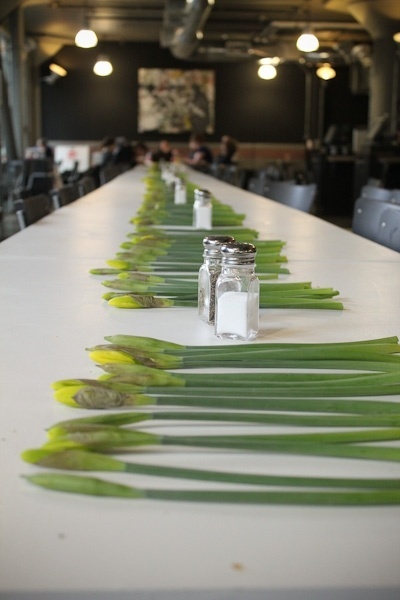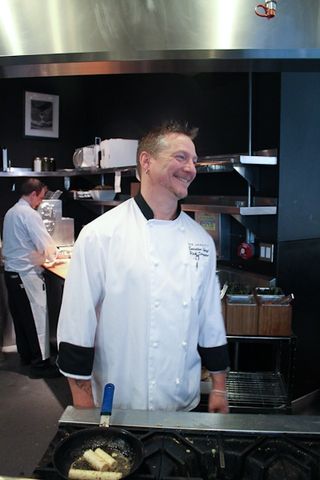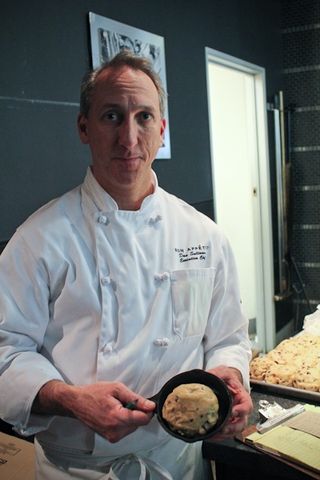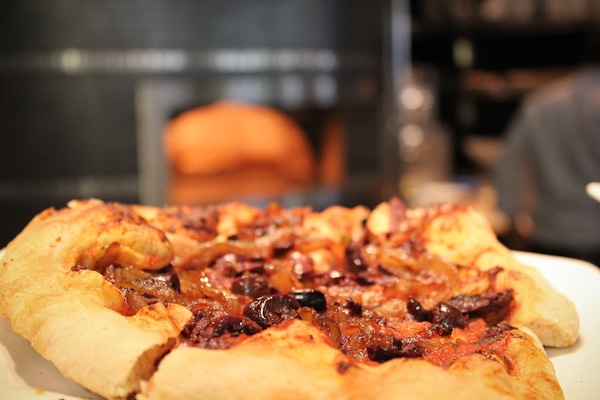Musings on community, art, and low carbon food
- by Vera Chang
By Vera Chang, West Coast Fellow for Bon Appétit Management Company Foundation
 An art project in Cornish Cafe by a sculpture student
An art project in Cornish Cafe by a sculpture student
Written in honor of a creating a more peaceful world through eating alongside one another and low carbon choices
When you combine an arts school and a socially responsible food services company, the results can be interesting. Last Thursday, on April 14, Bon Appétit Management Company celebrated its fourth Low Carbon Diet Day, and Cornish College of the Arts transformed this annual event into an occasion in which eating was revered as art, and art added another dimension to sustainable dining.
 On Low Carbon Diet Day eaters (like you) are encouraged to eat like they give a darn and make food choices to help reduce global greenhouse gas emissions. Low Carbon Diet Day menus make a point of swapping items with beef and cheese, which are from methane-emitting ruminant animals, with lower-foodprint animals and “beefing up” the vegetarian and vegan offerings as well as locally sourced and low-waste items.
On Low Carbon Diet Day eaters (like you) are encouraged to eat like they give a darn and make food choices to help reduce global greenhouse gas emissions. Low Carbon Diet Day menus make a point of swapping items with beef and cheese, which are from methane-emitting ruminant animals, with lower-foodprint animals and “beefing up” the vegetarian and vegan offerings as well as locally sourced and low-waste items.
Some of the beautiful and flavorful dishes from Cornish Executive Chefs Rick Stromire (left, cooking with hearts of palm) and Dan Sulllivan included wood-fired cheeseless pizzas topped with Ostrom’s crimini mushrooms, kalamata olives, and fresh thyme. House-made (local, naturally raised) turkey burgers with caramelized Walla Walla sweet onions replaced beef on the grill station. And Island Spring seared tofu, local fingerling potatoes, and a bed of frisee salad drizzled with citrus sang on plates.
A long table designed by a Cornish sculpture student at the center of Cornish Café obliged friends and strangers to sit and eat the company of others. Once you’ve decided what your low carbon lunch will be, it is best not to eat hurriedly or eat alone. Especially since this meal may challenge you to try something outside of your normal habits and think about food differently. Where did your food come from, and how did it get here? There are hidden environmental costs to air-freighting foods; local, seasonal foods are generally the lowest carbon choice unless you’re talking about beef and cheese; and hothouses powered with non-renewable energy are a big no-no. Was it processed and packaged or cooked from scratch? Highly processed foods, usually wrapped in plastic for resale, depend heavily on petroleum to produce, so house-made with the simplest, purest ingredients is best.
 Is there beef, cheese, or dairy in your meal, or alternative proteins to choose from? Livestock contributes 18% of the world’s greenhouse gas emissions, so legumes and locally produced chicken, fish, and tofu are better choices. For more info, check out our Low Carbon Diet Calculator.
Is there beef, cheese, or dairy in your meal, or alternative proteins to choose from? Livestock contributes 18% of the world’s greenhouse gas emissions, so legumes and locally produced chicken, fish, and tofu are better choices. For more info, check out our Low Carbon Diet Calculator.
While there is certainly a science behind Bon Appétit’s Low Carbon Diet, it doesn’t take a scientist to realize that food, musings, and community go hand in hand. On Low Carbon Diet Day, food is more than just fuel for our bodies – low carbon foods propel climate solutions and the creation of a more just and sustainable future. Beyond food, community is also key, since we cannot stop climate change on our own.
Yesterday, as I chatted with students, I thought about how simply taking burgers off the grill without eating and engaging with each other would be only half of the point of Bon Appétit’s annual celebration. With every bite, we are speaking to the environment, since food comes from and also impacts the natural world, and to those around us, both those with and without a seat at the table. Food is, in fact, a part of art, and this sculpture and Low Carbon Diet Day invite us to challenge the way we’ve been eating, discuss, and reconnect with our fellow humans and the wider world.
Above: Low carbon cheeseless pizza with kalamata olives and fresh thyme
Above right: Executive Chef Dan Sullivan with Cornish Cafe’s famous chocolate chip cookies.
